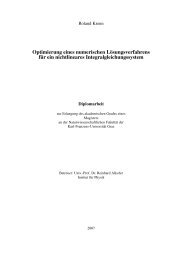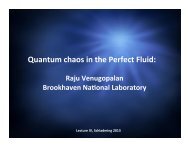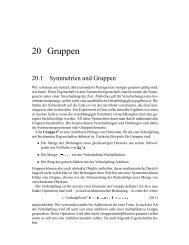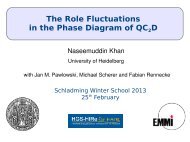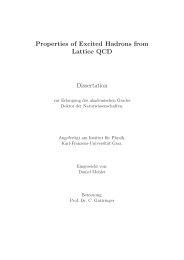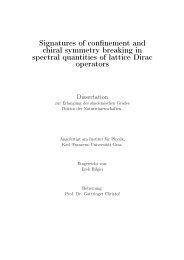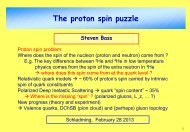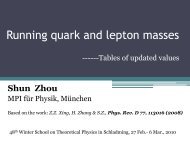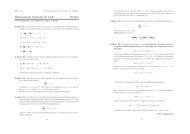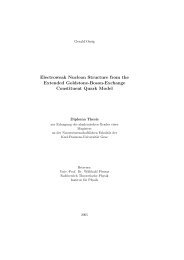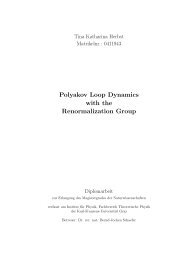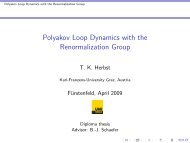The QCD Quark Propagator in Coulomb Gauge and - Institut für Physik
The QCD Quark Propagator in Coulomb Gauge and - Institut für Physik
The QCD Quark Propagator in Coulomb Gauge and - Institut für Physik
You also want an ePaper? Increase the reach of your titles
YUMPU automatically turns print PDFs into web optimized ePapers that Google loves.
Chapter 2. Chiral Symmetry Break<strong>in</strong>g <strong>in</strong> <strong>QCD</strong> 11<br />
As mentioned above the quantitative considerations of this subsection are all valid <strong>in</strong><br />
L<strong>and</strong>au gauge. Nevertheless <strong>in</strong> <strong>Coulomb</strong> gauge we def<strong>in</strong>e a mass function <strong>in</strong> the same way<br />
as above <strong>and</strong> are able to show, that it exhibits a behaviour as the one <strong>in</strong> L<strong>and</strong>au gauge<br />
for low momenta.<br />
2.3 <strong>The</strong> pion as a Goldstone boson <strong>and</strong> PCAC<br />
From the fact that the vacuum expectation value 〈Ω|ΨΨ|Ω〉 does not vanish we can conclude<br />
by consider<strong>in</strong>g the proof of the Goldstone theorem that the axial currents A r µ (x)<br />
couple the Goldstone bosons to the vacuum. If we denote the one particle states of the<br />
Goldstone bosons with momentum p as |π s (p)〉, this is expressed as [Ynd, CL, Pok]<br />
〈Ω|A r µ(x)|π s (p)〉 = if rs p µ e ipx , r, s = 1, 2, 3 , (2.29)<br />
where the f rs are nonvanish<strong>in</strong>g constants. If we assume that the SU(N f ) isosp<strong>in</strong> symmetry<br />
is unbroken, they may be written as<br />
f rs = δ rs f π . (2.30)<br />
For N f = 2 f π is the pion decay constant. It can be measured <strong>in</strong> weak π decays, s<strong>in</strong>ce the<br />
matrix element (2.29) enters there. For <strong>in</strong>stance for the decay π → µν we have<br />
G 2 m 2<br />
Γ = fπ<br />
2 µ (m2 π − m2 µ )2<br />
cos 2 θ<br />
4πm 2 c , (2.31)<br />
π<br />
where G is the the weak decay constant <strong>and</strong> θ c the Cabibbo angle. From experiment<br />
f π ≈ 92 MeV is known. For three flavours the kaon decay constant is approximately<br />
f K ≈ 1.2f π .<br />
Apply<strong>in</strong>g the four divergence to equation (2.29) <strong>and</strong> us<strong>in</strong>g the Kle<strong>in</strong>-Gordon equation<br />
one can derive<br />
〈Ω|∂ µ A r µ (x)|πs (p)〉 = δ rs f π m 2 π eipx . (2.32)<br />
If chiral symmetry of the <strong>QCD</strong> Lagrangian was exact, we could <strong>in</strong>fer m π = 0 or f π = 0 from<br />
the conservation of the axial current. This is true <strong>in</strong> the Nambu-Goldstone <strong>and</strong> Wigner-<br />
Weyl realisation of chiral symmetry. Because both quantities do not vanish, it follows<br />
immediately that chiral symmetry is explicitly broken. S<strong>in</strong>ce on the other h<strong>and</strong> the pions<br />
are sizeably lighter than the rest of the mesons, the current quark masses of up <strong>and</strong> down<br />
quarks, which are responsible for this explicit break<strong>in</strong>g, are quite small compared to the<br />
typical energies of strong <strong>in</strong>teraction. For the relevant case of explicit symmetry break<strong>in</strong>g



